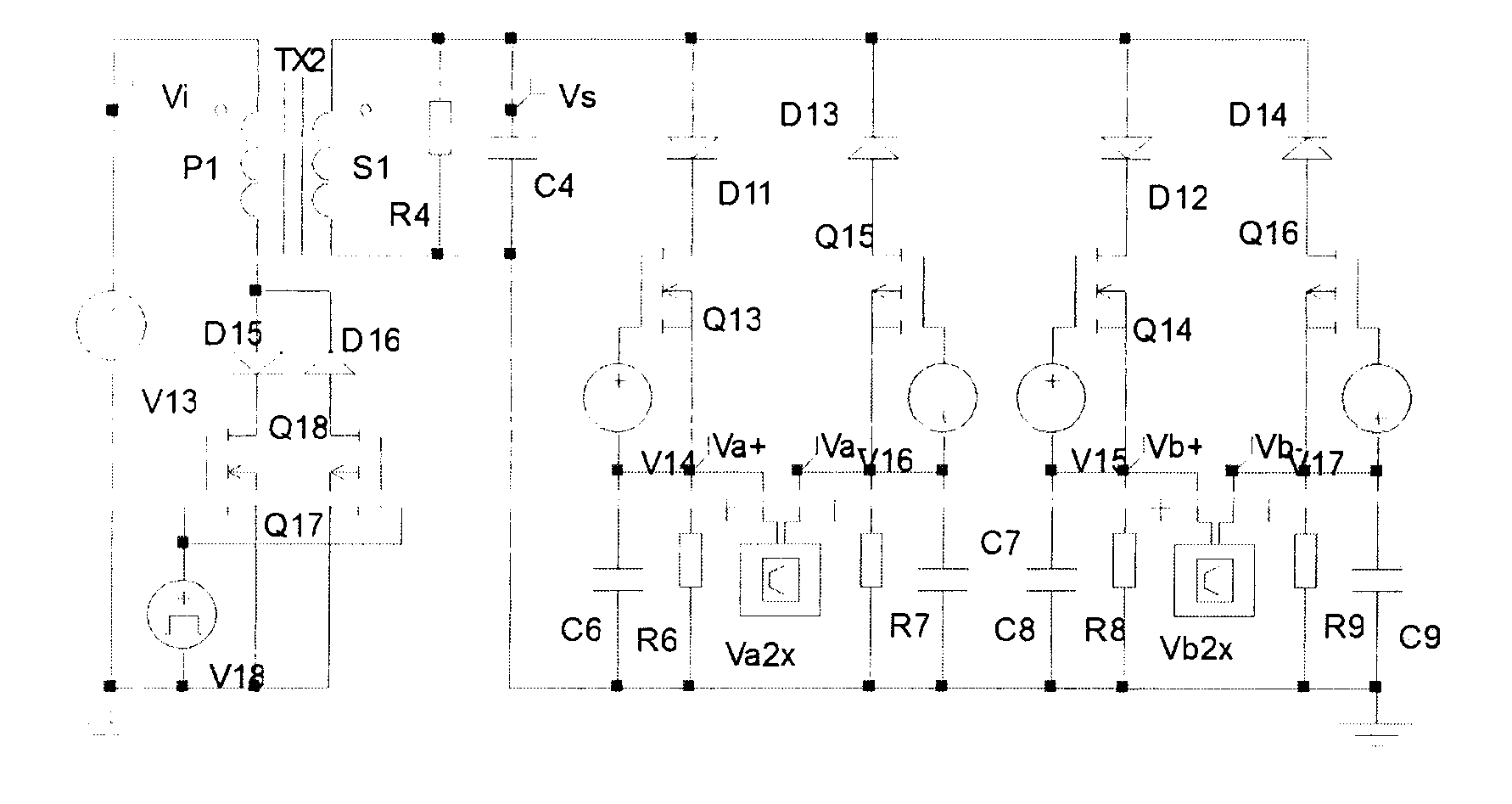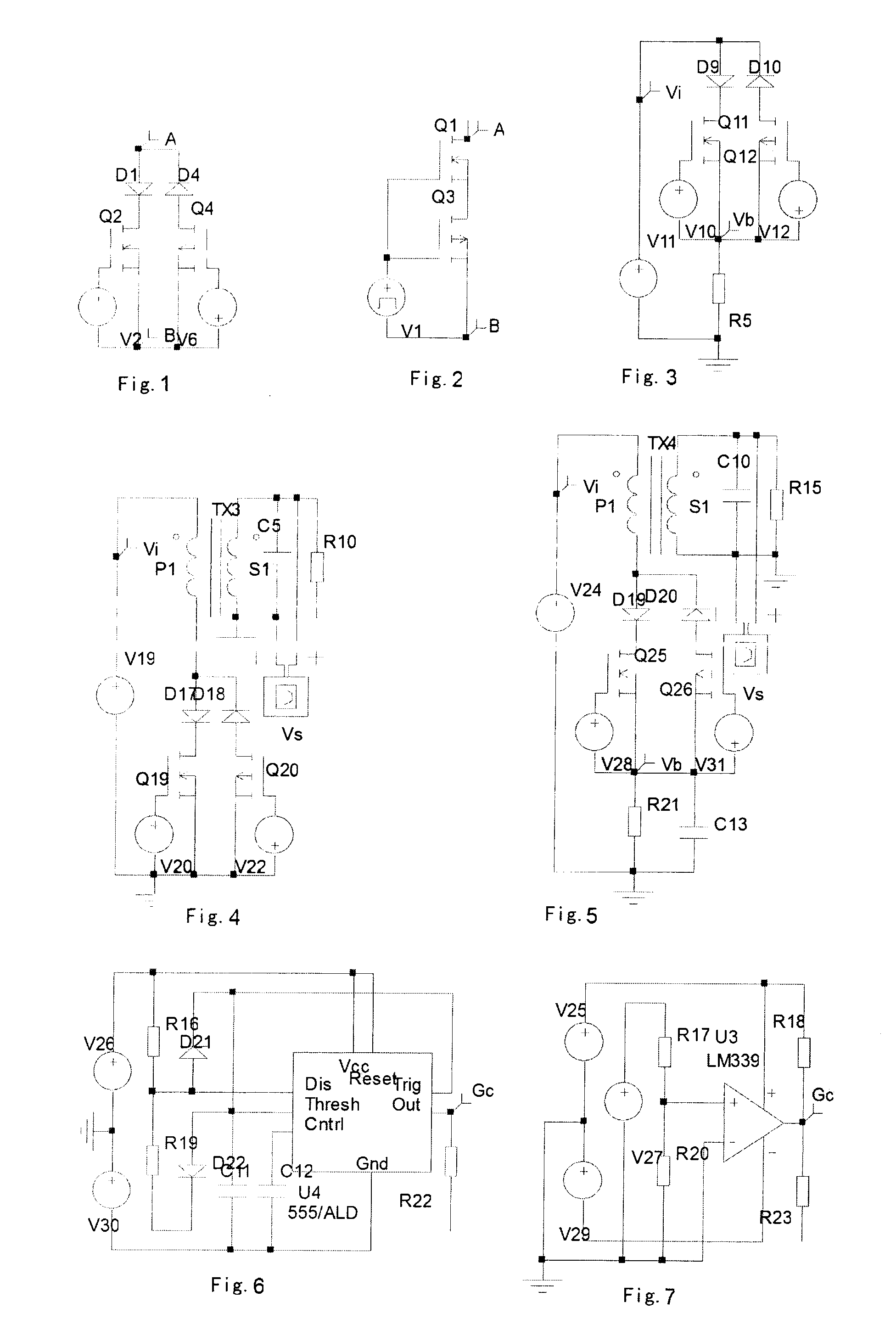Green Power Converter
a power converter and green technology, applied in the direction of dc-dc conversion, dc-dc network circuit arrangement, efficient power electronics conversion, etc., can solve the problems of greying and dark world, traditional power conversion cannot be performed in order, etc., and achieve the reduction of circuit complexity, power consumption and failure rate of the whole power converter.
- Summary
- Abstract
- Description
- Claims
- Application Information
AI Technical Summary
Benefits of technology
Problems solved by technology
Method used
Image
Examples
embodiment 1
AC Inverter Power Source
[0081]FIG. 16 is an AC inverter power source, the MOS tubes Q25, Q27 and the like form a type A unit circuit SBPA, the common drain electrodes are connected with the transformer TX2 to form a basic circuit (2.2), the transformer secondary side is a dynamic rectification circuit (3.4) composed of Q17, Q18, Q19, Q20, Q23, Q24, Q28, Q29, C2 is a capacitor with smooth action, V17 is a mains supply, V18, V19, V25, V26 are positive and negative symmetrical VDvrs type synchronous driving signals, and V22, V24 are VDvrh type high-frequency driving signals. Assuming that the amplitude of the input voltage V17 is 280V, the transformation ratio of the transformer TX1 is 1:0.3, the load resistor R7 is 50 Ohm, and the AC voltage V0 with 80V output amplitude is obtained on the resistor R7. In the simulation waveform of FIG. 72, the components are successively as follows: input voltage Vi, double-sideband square-wave voltage Vs enveloped as sine wave at transformer secondar...
embodiment 2
DC Inverter Power Source
[0082]FIG. 17 is a DC inverter power source, and MOS tubes Q33, Q34, Q37, Q38 form a main circuit. Because the input voltage is DC, the polarities of the MOS tubes forming the unit circuit are the same, and meanwhile, the diodes connected with the MOS tubes are omitted. The external voltage V16 is a 311V DC voltage, the driving signals V24, V25 are square-wave signals of 50 Hz, V25 delays 10 ms, the driving signals G1, G3 are high-frequency square-wave signals generated by Q29, Q30 and enveloped as sine-wave steamed bun wave, and G3 delays 10 ms. During the first 10 ms period, Q33, Q38 are conducted, the DC voltage flows across the TX3 primary side winding, Q33, R12, Q38 to form a loop, a sine-wave forward steamed bun wave high-frequency square-wave voltage identical to the G1 envelop is generated on R12, and a double-sideband sine-wave steamed bun wave high-frequency square-wave voltage is generated on the secondary side of TX3. During the last 10 ms period,...
embodiment 3
AC Voltage-Stabilized Power Source
[0088]FIG. 18 is the schematic circuit of the AC voltage-stabilized power source, power devices Q1, Q3 form a type A unit circuit SBPA, the resistor R7 is connected with the common source electrodes to form a unit circuit (2.1), the amplitude height modulation equivalent resistor AHM20k(Vo)1 and the resistor R6 are biasing circuits of grid electrodes of Q1, Q3, and the input voltage Vi is sine wave with 360V amplitude. The output voltage Vo tracks the grid electrode voltages of Q1, Q3. When the upper biasing resistor varies between 10 k and 100 k, the output voltage V0 varies between 300V and 170V, i.e. the AC output voltage is adjustable, and FIG. 74 is the simulation waveform of the output voltage. When the load resistor R7, the input voltage Vi or the temperature T varies, the output voltage Vo correspondingly varies, the amplitude height modulation circuit (4) is started at the moment, and the result of closed-loop control enables the output vol...
PUM
 Login to View More
Login to View More Abstract
Description
Claims
Application Information
 Login to View More
Login to View More - R&D
- Intellectual Property
- Life Sciences
- Materials
- Tech Scout
- Unparalleled Data Quality
- Higher Quality Content
- 60% Fewer Hallucinations
Browse by: Latest US Patents, China's latest patents, Technical Efficacy Thesaurus, Application Domain, Technology Topic, Popular Technical Reports.
© 2025 PatSnap. All rights reserved.Legal|Privacy policy|Modern Slavery Act Transparency Statement|Sitemap|About US| Contact US: help@patsnap.com



